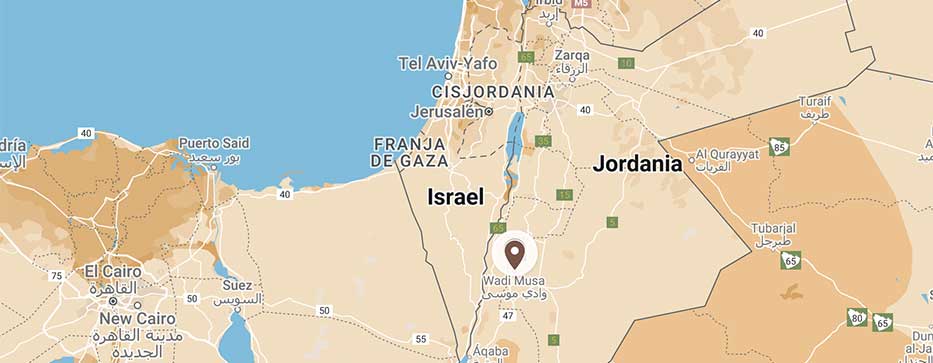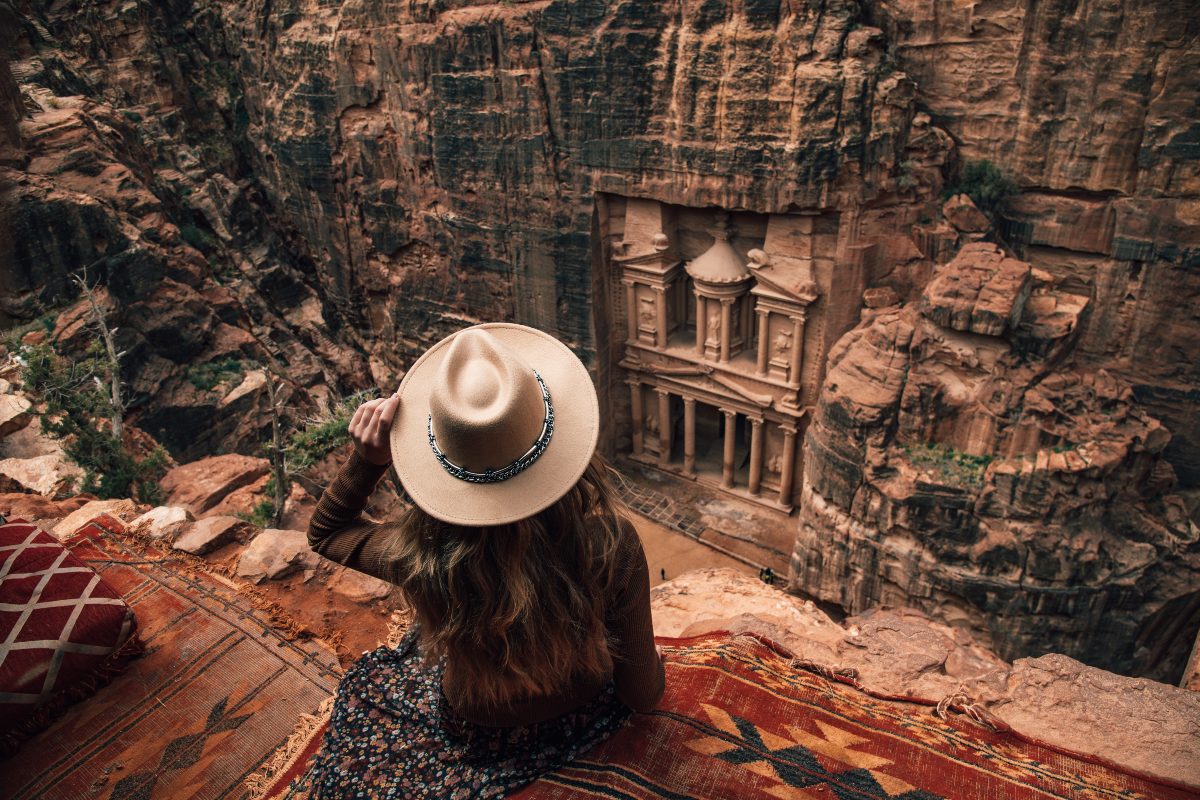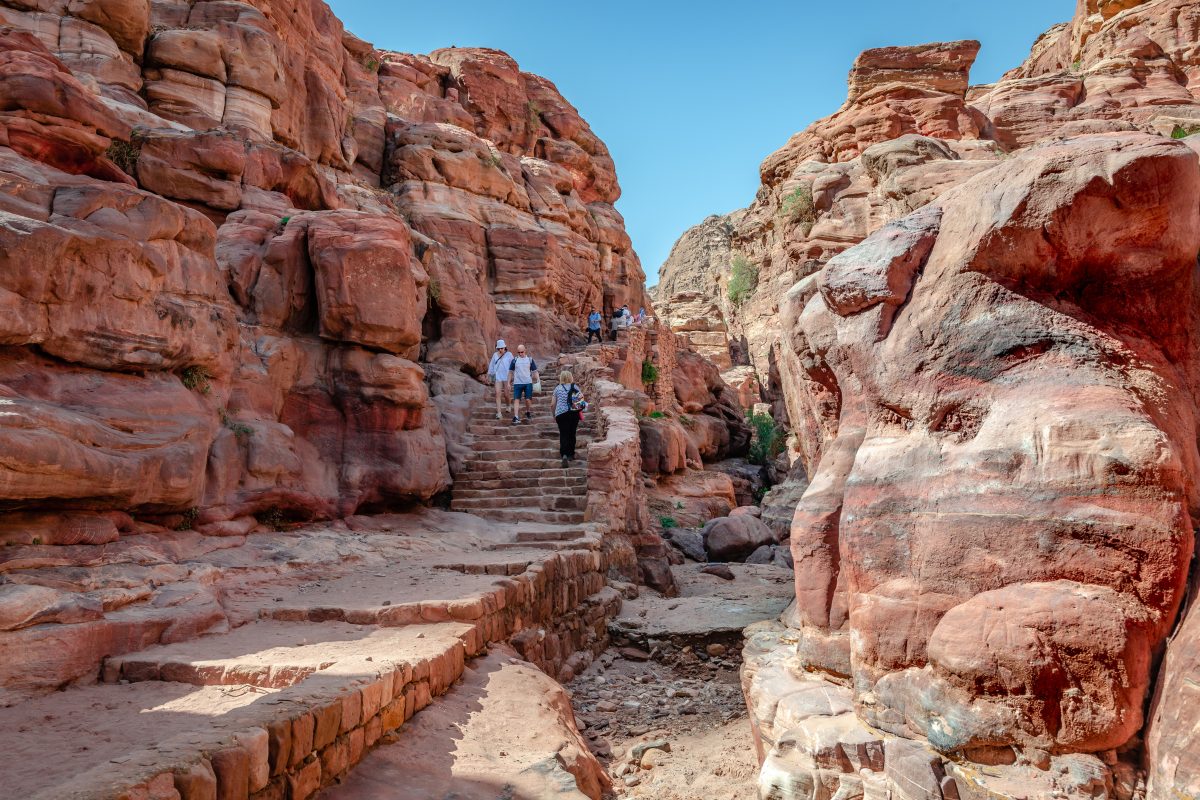Petra is, without a doubt, Jordan’s great tourist attraction. And not by chance. Also called the ‘Pink City’, its extraordinary originality makes it a unique place in the world, which has fascinated travellers of all periods. It can boast of having two top-level distinctions, which act as an unbeatable letter of introduction: it is a UNESCO World Heritage Site and was chosen as one of the Seven Wonders of the Modern World.
For this reason, for Jordan Exclusiva it occupies a central place: all our tours to Jordan dedicate one or more days to its discovery, with the help of the best professionals. And on this page we tell you everything you need to know before you get to Petra: what to see, what is the weather, how to get here, what activities to do, etc.
Petra is located in south-central Jordan and is part of Ma’an Governorate. It is located about 150 km from the Dead Sea and about 230 km from the capital, Amman. A little closer are other points of interest located to the south: it is about 90 km from the Wadi Rum nature reserve and about 130 km from the Red Sea city of Aqaba.
The ancient city of Petra, as it has survived to the present day, is a protected monumental and historical space, but no one lives in it anymore. On the other hand, the nearest town is Wadi Musa, a small town that currently lives ‘by and for’ Petra (
what to see
in Wadi Musa): here are concentrated restaurants, hotels, shops and other places that serve visitors to the ‘Pink City’. Therefore, your visit to Petra will inevitably pass through Wadi Musa.
Petra is located in an extremely arid area, so its climate is that of the desert. The nights are cool in summer and really cold in winter, to which we must add the ‘microclimate’ that occurs in the parts of the rocky canyon never exposed to the sun, which contributes to maintaining relatively low temperatures. Instead, the days are extremely warm in the months of July and August, especially in areas of great sunshine. The best months to visit this tourist destination are March, April and May, where some wadis even bloom, as well as in the autumn months of October and November.
In any case, Petra receives visitors throughout the year, including the winter and summer months, even though the cold and rain (winter) and extreme heat (summer) can make travel difficult. If that is the time planned for your trip, you will need to adapt your clothes and care to those weather conditions so that they do not prevent you from enjoying your visit.

Petra is inextricably linked to the Nabataeans and the Romans, but before them this area was already inhabited. Specifically, in Neolithic times: the settlement of Beidha, about 10 km to the north, is dated around 7000 BC and represents one of the first Neolithic communities in the Near East (which, in turn, is the ‘cradle’ of these populations that revolutionized the life of man and his relationship with the environment).
But it was the Nabataean tribes that truly made it possible for Petra to become the spectacular city that every traveler has today. What to see. In Petra they settled around the sixth century BC, where they constituted a kind of ‘warehouse city’ that they called Raqmu, very well positioned geographically: through here passed the routes that connected Syria, Egypt and Arabia.
The Nabataeans were mainly skilled and very well organized merchants, who knew how to use their profits to beautify this city. But they also had good scribes (the Nabataean language is considered a precursor of Arabic) and hydraulic engineers who built dams and canals to provide water to Petra. A water that, by the way, came from Ain Musa, a source that according to Jewish and Christian belief emerged in the thirteenth century BC following a miraculous rod blow of the prophet Moses, which is currently in neighboring Wadi Musa.
The city once had about 30,000 inhabitants and some of its kings have gone down in history for their great leadership, such as Aretas III and Aretas IV in the first centuries B.C. and A.D. At that time, Nabataea reached its maximum territorial extent, including the conquest of Damascus and other areas of present-day Jordan and Saudi Arabia. Architecturally, the Nabataeans assumed a style of their own, strongly inspired by Hellenistic, Phoenician and Mesopotamian forms.
However, around 105 AD the Roman Empire, a rising power in the area, ended up annexing Nabataea, in a moment of weakness after seeing how Palmyra (present-day Syria) took away its strategic role in the area’s trade routes. However, the Romans promoted a restructuring of Petra, erecting new constructions and making it the capital of the province Palaestrina Tertia.
Things began to go seriously wrong after the earthquake of 363, as the city was seriously damaged. In the fifth century, however, the Byzantines, ‘heirs’ of Rome, continued to build some structures, such as the church, or reuse others, such as the Al Deir monastery.
The final decline came with a new earthquake in the sixth century: the devastation caused was no longer reversed and Petra was left as a lost city only used by the Bedouins, who jealously guarded its secret for centuries.
A secret that was discovered in 1812 by the Swiss Jean Louis Burckhardt, in a period of real exploratory fever in the Middle East: dressed as a Bedouin, he arrived at this place and made it known to his contemporaries and successors: fortune hunters first and archaeologists later.
In fact, the 20th century was a period of great archaeological discoveries, which still continue today (justlook at the Petra Museum to realize it). In addition, the place was opened to tourism, boosted by the ‘priceless’ promotion that was the film of
Indiana Jones and the Last Crusade
, which forever immortalized the Treasury as a temple of the Grail.
In 1985 it was declared a World Heritage Site by UNESCO and that forced some people (the last ones) who lived or dwelt here to move to the nearby town of um Seyhoun, built largely to house these semi-nomadic Bedouins.

Find out what to see in Petra and how to organize the visit, it is useful to know how this tourist site is distributed. Broadly speaking, we can speak of the following nuclei or spaces:

Scattered throughout the aforementioned towns, you can draw up a very extensive list of monuments and places to see in Petra. There are about 800 different structures or constructions, of which about 500 would be only tombs. Some of these structures are spectacular for their good state of conservation, while others have come down to us only in the form of ruins or archaeological remains.
But knowing them all or mostly will allow you to get an overview of what really was that great city that its inhabitants called Raqmu and the Romans, Petra.
To all these monuments to see in Petra we add one more place, fundamental to better interpret this spectacular historical enclosure: the Petra Museum, recently built. It is located in Wadi Musa, next to the visitor center, so you can
visit that page of our website
for more information.

Yes, in addition to everything there is to see in Petra On a monumental level, you want to take a natural route through its surroundings, you have different possibilities. This is a proposal designed for those travelers with greater physical background and experience in hiking activities, since the distances can be long and the slopes, demanding, since the environment of Petra is full of
Wadis
and rugged roads.
But the effort is worth it: the landscapes that can be contemplated, especially from the various natural viewpoints, are spectacular. Here are some suggestions:

If after all you have to see in Petra If you want to do a related activity, you will find proposals that show the ‘Pink City’ and its surroundings in other different ways. For example, there are horseback rides in the surrounding hills, aimed mainly at those who are proficient in horseback riding. Also very popular are the night circuits, which show some of the main monuments illuminated. In addition, it allows you to enjoy the mantle of stars and the radiant Moon that usually characterize the sky of Petra at night.
Already in Wadi Musa there are other alternative proposals that have nothing to do with Petra directly, perhaps to complement the experience or to rest from the visit, such as enjoying a Turkish bath, as there are several establishments of this type. It is in Wadi Musa that you will find most of the souvenir shops, hotels and restaurants, in some of which can be carried out Local cooking masterclasses.
In addition, different types of events are held at certain times of the year. Highlights include performances by the Jordan Heritage Revival Company, which dramatize ancient Nabataean and Roman life in the city. And for running lovers, the Petra Desert Marathon will be a great opportunity to discover this place and its surroundings in a different way: practicing their favorite sport.
And of course, you will always have the option to visit
Little Petra, as we explain on this other page.
As we said above, to visit Petra you must go to Wadi Musa, which is the town that gives access to this tourist site. The Kings Highway, one of the great north-south axes of the country, passes through here. For this reason, the private vehicle option is one of the simplest and most used to get to Petra. Here are some distances, with their respective durations, to give you an idea of the trip:
If you prefer public transport, the bus company JETT has Petra as one of the most outstanding stops in its network: buses arrive here from different places, mainly from Amman (7th Circle and Abdali), but also from Wadi Rum and from Aqaba. From these last two places there are also minibuses daily, although they are less comfortable because the schedules are indicative and depart only when they are full.
In Petra, for obvious reasons related to its orography, it is impossible to use motor vehicles. Therefore, to move around here you will have to walk a lot, so it is recommended to wear shoes with robust soles and comfortable clothing (breathable or thermal, depending on the time of year).
There is also the alternative of animals: from the visitor centre to the Treasury and the rest of the places of interest, you can go on the back of horses, donkeys, mules or camels, whose reins are usually in the hands of local Bedouins, experts in this work. These ‘means of transport’ are also concentrated in the so-called ‘back door’, a space located next to the Qasr al Bint, with some restaurants, from where the routes to the Monastery depart and where Bedouin workers living in Uum Sayhoun access.
Although on this page we explain what to see in Petra, you’ll definitely want to know about other information resources for your visit. We suggest you take a walk before the Visitor Center where, in addition, there is the box office to get tickets to the site. The exact address is Tourism St. In this center you can get maps and other brochures that will be very useful.
Inside the Petra compound you will find some tea shops and restaurants, as well as some souvenir shops, although not with the variety of Wadi Musa. In them or at other points you will also find public toilets, which are strongly recommended to use so as not to deteriorate the environment.
And if you have any major setbacks, you should know that there is a tourist police station in the Visitor Center complex, a Hospital a few kilometers south of Petra (King’s Road, direction Al Tayyibeh) and pharmacy in the urban area of Wadi Musa.






Fill out the form below to receive a free non-binding quote tailor-made by a specialized agency in Jordan.
DMC travel agency specializing in tailor-made trips to Jordan
Mandala Tours, S.L, NIF: B51037471
License: C.I.AN-187782-3